HENRY THE EIGHTH OF HORTICULTURE
How to “Make” a New Tree
Visitors to my garden this time of year are often astonished to see me lopping the tops off some of my trees. No, I’m not the Henry the Eighth of horticulture, chopping the head off any tree that no longer meets my fancy. Okay, I AM actually lopping the head off any tree that doesn’t meet my fancy.
I part ways with Ol’ Henry, though, because, first, lopping the head off a tree doesn’t kill it and, second, I graft on a new head. (Something Henry could not do.) A few years after this seemingly brutal operation, the tree looks as chipper as ever. And it has a head that I like better — or else off it comes again.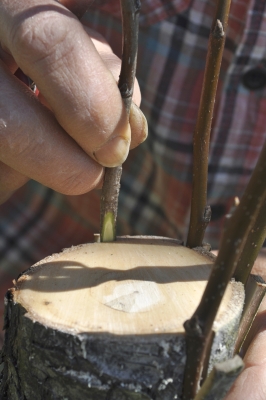
I do this type of grafting, called topworking, mostly on my pear trees, but it could equally be applied to many other kinds of fruit or ornamental trees. For instance: If you didn’t like the growth habit of your red maple or the leaf shape of your Japanese maple, you could just lop back the head and change it. Same goes for the flower color of a crab apple or flowering cherry. A pink dogwood stem could be grafted onto just one large limb of a white dogwood tree to create a bi-colored flowering dogwood.
Each time I lop back one of my pear trees, I can make that tree into any one of the more than five-thousand other varieties of pear.
What’s Needed
Before you can topwork any tree, you have to have in hand stems, called scions, of the variety to which you want to change the plant. You might get scions from a neighbor’s or friend’s tree that you have admired. I often get scions mailed to me from other fruit-growing enthusiasts elsewhere across our fruited plain, or from government institutions. (I belong to North American Fruit Explorers, www.nafex.org, an organization of fruit “nuts” that’s also a good source for scions.)
Healthy portions of the previous year’s growth cut into pieces a foot or so long, are the stems of choice for scions. Scions can be collected when stems are dormant and leafless, from winter to early spring and temperatures are above freezing.
Once you have scions in hand, get them out of hand and into the refrigerator. Wrap them well in plastic, perhaps with a damp rag to keep them plump with moisture. Even better, wrap them in plastic, wrap the plastic with a damp rag, then put all that into another plastic bag, well sealed.
The ideal time for topworking is when buds on the to-be-decapitated tree are just beginning to grow; the scions are still under refrigeration in their winter sleep. This way, the scion has time to knit to the lopped back trunk and hook up its plumbing before its buds expand into thirsty new shoots.
The Cuts, and More
 The actual grafting operation is simple and there are a few ways to do it. The method I’ll describe is the bark graft, which gardeners have done for thousands of years and is best done on trunks more than about two inches across. I used this graft to change the variety of my brother’s crabapple tree, which had a trunk eight inches in diameter.
The actual grafting operation is simple and there are a few ways to do it. The method I’ll describe is the bark graft, which gardeners have done for thousands of years and is best done on trunks more than about two inches across. I used this graft to change the variety of my brother’s crabapple tree, which had a trunk eight inches in diameter.
I particularly like the bark graft because it comes with an “insurance policy;” the cut surface of the trunk can accommodate a few scions, increasing the chances that at least one takes. Often, they all do.
Bark grafting is among the methods of plant propagation for which I provide the “why” and the “how” in my book The Ever Curious Gardener: Using a Little Natural Science for a Much Better Garden.
The first step is to do the Henry the Eighth move, lopping the trunk back to a desired height. My preference is for a convenient working height of three to four feet. I make the cut at a slight angle so that the cut surface sheds rainwater.
I prepare a scion for a bark graft with a bevel cut about two inches long at its base, not quite all the way across from one side to the other. On the opposite side of the cut, I nick off a short bevel.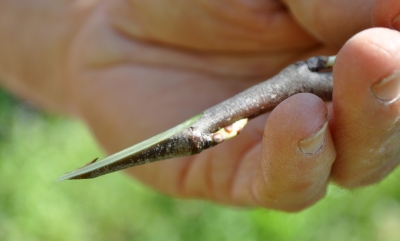
Then, into the upper portion of the freshly cut stub of the rootstock, I make two vertical slits through the bark, each about 2 inches long and as far apart as the width of the base of the scion. 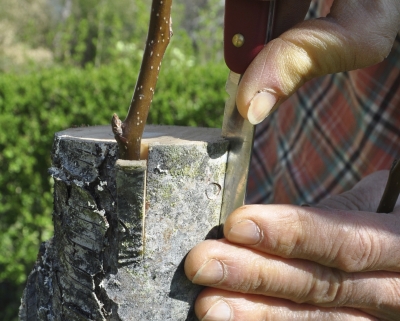 Carefully peeling back the flap of bark welcomes in the long, cut surface of the scion, putting the inner bark layers of rootstock and scion in close contact. This is repeated with the other scions, all around the stub.
Carefully peeling back the flap of bark welcomes in the long, cut surface of the scion, putting the inner bark layers of rootstock and scion in close contact. This is repeated with the other scions, all around the stub.
With the peeled back flaps of bark from the rootstock pushed back up against each inserted scion, one or two staples from a staple gun or a tight wrapping with stretchy electrician’s tape suffices to hold scions in place.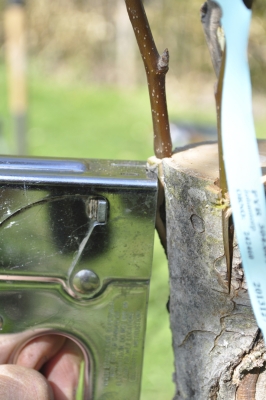
Finally, everything needs to be sealed against moisture loss. I liberally paint all cut surfaces with a commercial product called Tree-Kote®. Other products are also available for this purpose.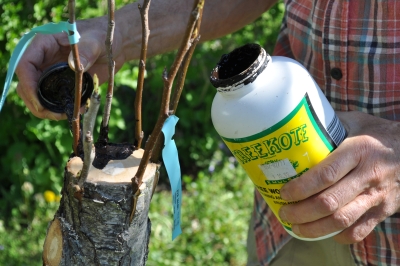
Once any of these grafts is completed, I don’t just turn my back on it, walk away, and expect success. I check my grafts the following day and reapply sealant, as needed.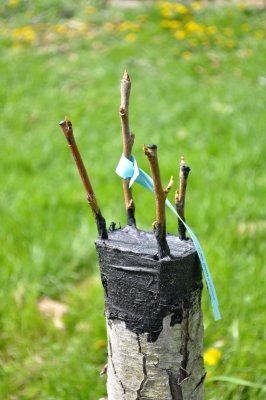
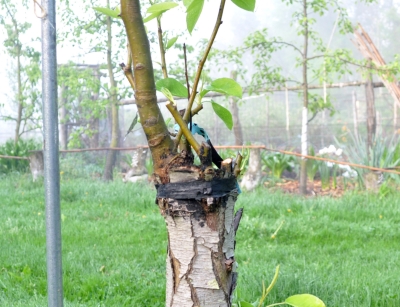
Year 2 of bark graft
The year following a bark graft, I reduce “takes” to the single, most vigorously growing scion, not totally removing but shortening all the other “takes” to help the large cut on the trunk in healing over. Eventually, they’ll be cut away in toto.
If your timing is right, and trunk and scions are in good contact, stand back, because with an established root system it’s possible to get three feet or more of growth from a scion in its first season!

Summer growth after spring grafting


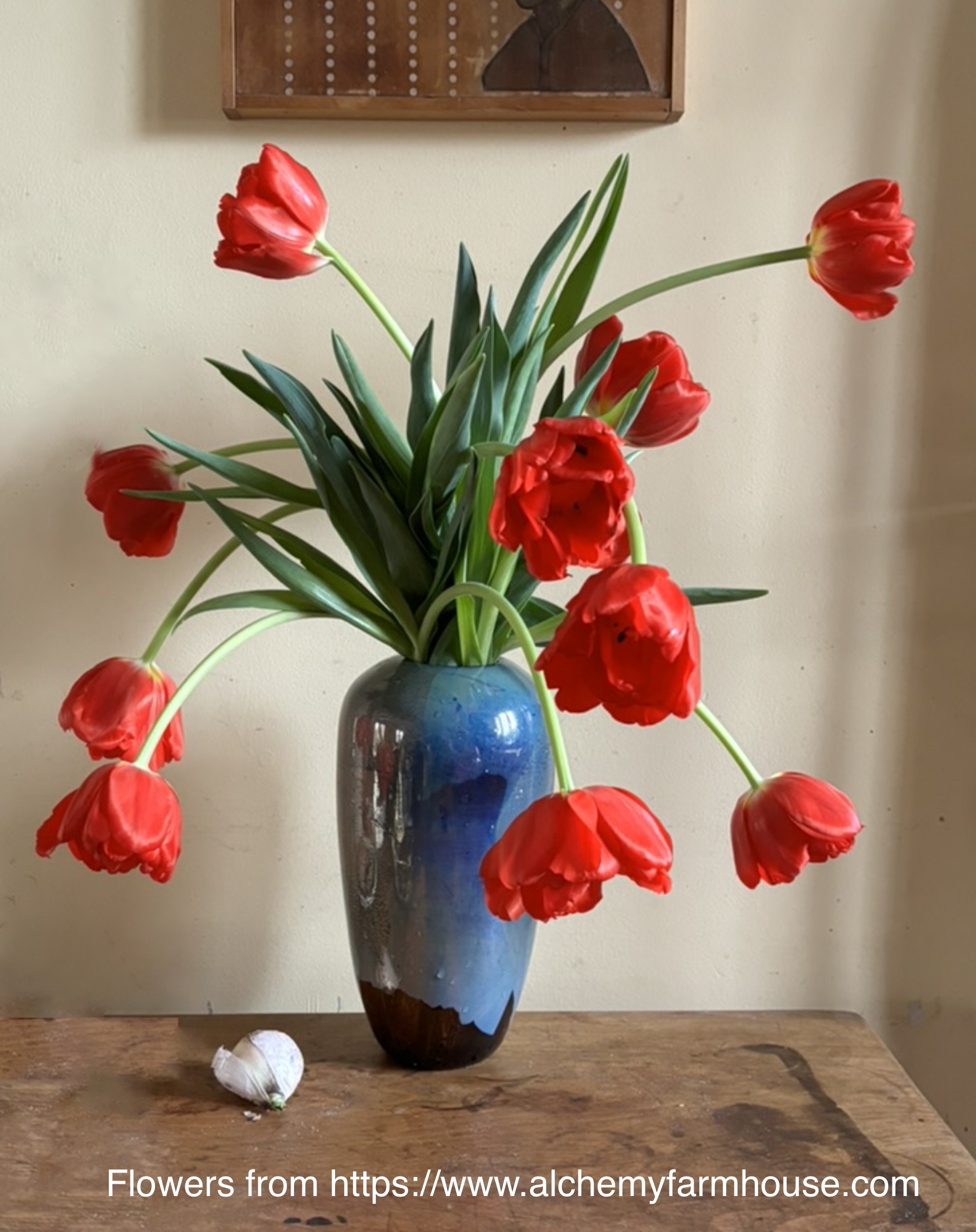
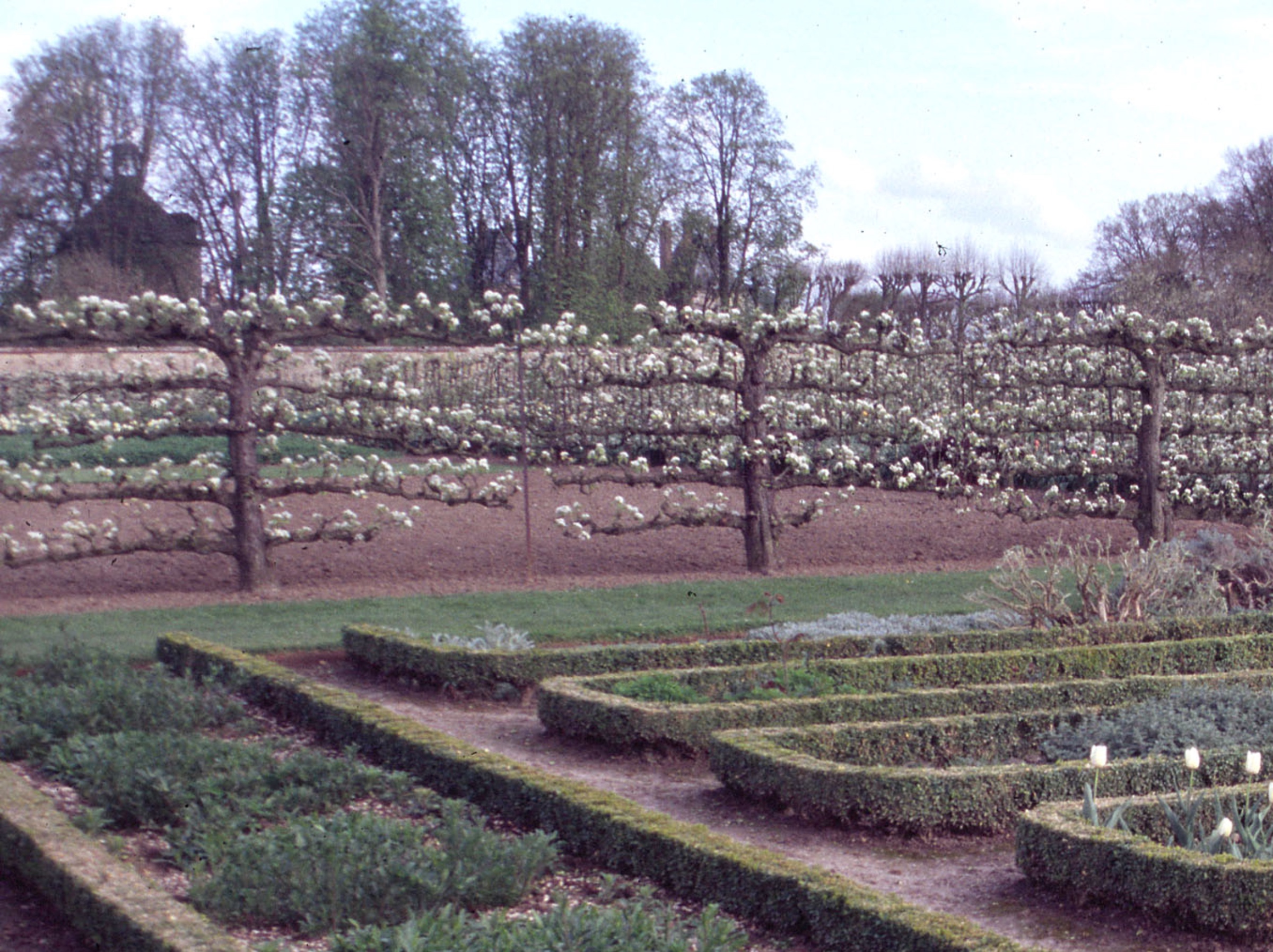
looks pretty complicated
no, really, it isn’t.
That’s awesome! Thank you.
Thanks for reading.
Looks great why do the scion have to be 2 year old growth? Could you bark graft on a younger tree? Have you ever tried this method with something like your hardy kiwis?
Scion is best if ONE year old, that is, a stem that grew the previous season. Bark graft could be done on trees only an inch or so in diameter, but for those I use cleft graft.